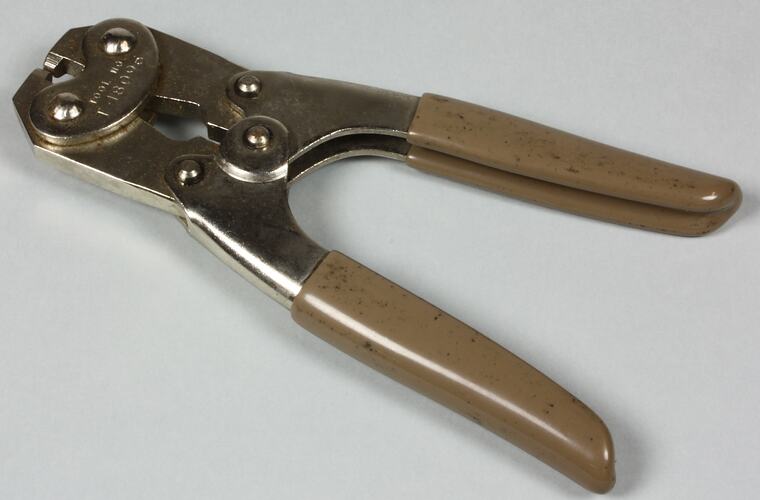Summary
A Friden Flexowriter Peening Tool. Used by the donor in his capacity as maintenance engineer for Friden Flexowriter equipment. He had responsibility for the Flexowriters used with CSIRAC at the University of Melbourne.
The Friden Flexowriter was a teleprinter, a heavy duty electric typewriter using different inputs: manual typing as well as automatically through for example the use of a computer or paper tape. Flexowriters were in use from the 1920s to the 1970s.
A peening tool is one of several tools used to align the height, depth and angle of typeslugs (in a typewriter) as they hit the paper.
Physical Description
An hand-operated tool. Metal handles with beige plastic grip coat. Handles are hinged together at the top and are also hinged to the head of the tool (two pieces of steel pinned together by kidney-shaped plates on both sides). The tip of the head is flat. When the tool is "closed" a square aperture is formed where the pieces of steel meet.
Significance
This item is part of a collection, which provides an important insight into the working of CSIRAC, Australia's first computer, the fourth in the world and now one of Museum Victoria's most significant technology artefacts. CSIRAC was custom built but one of its few commercially made peripheral components was the Flexowriter. This peripheral data and program preparation unit was introduced to CSIRAC's operation in 1962. A commercial 5 hole paper tape reader and punch had already been hooked up to CSIRAC in the late 1950s. The 5 hole paper tape equipment was introduced to bring CSIRAC's input and output format into line with the current standard of 5 hole paper tape being used by most of its organisational users, such as CSIRO. CSIRAC was originally built to use 12 hole tape, which was later used in tandem with the 5 hole tape. The Flexowriter was used to create data and program input for CSIRAC by punching out 5 hole paper tape. It could also read these tapes and produce a typed 'English language' version of the information represented by the holes in the tape. It could also duplicate punched paper tapes. By understanding how this piece of equipment worked, we have a broader understanding of CSIRAC's operation and its necessary evolution in the rapidly changing world of computing in the 1950s and 60s.
The collection is also important because it is the tool kit of the man who maintained Friden Flexowriters in Australia, and hence tells a story of 'working life'. The items in this collection were carried with the donor every day, as he travelled around Australia to the many sites that used Flexowriters in the 1950s and 60s. In conjunction with an oral history, this collection will tell the story of a career in an era when communications technology was still largely electro-mechanical and when loyalty to one's employer was de riguer. The donor stayed with the company that sold and serviced Flexowriters for his whole career, moving on to other products when the Flexowriter became obsolete.
Finally, the tools link to the story of the company that was licenced to sell and service Friden Flexowriters and hence to the early development of companies that provided technological products and support to the emerging computer market
More Information
-
Collecting Areas
-
Acquisition Information
Donation from Mr Tony Climpson, 17 Jul 2003
-
Manufacturer
Friden, United States, 1955-1964
Date is a guess based on the fact that the donor worked on CSIRAC in Melbourne. -
Date used
-
Inscriptions
FRIDEN INC. TOOL NO. T-18096
-
Classification
Computing & calculating, Digital computing, Paper tape equipment
-
Category
-
Discipline
-
Type of item
-
Object Measurements
152 mm (Length), 61 mm (Width), 16 mm (Height)
-
Keywords
